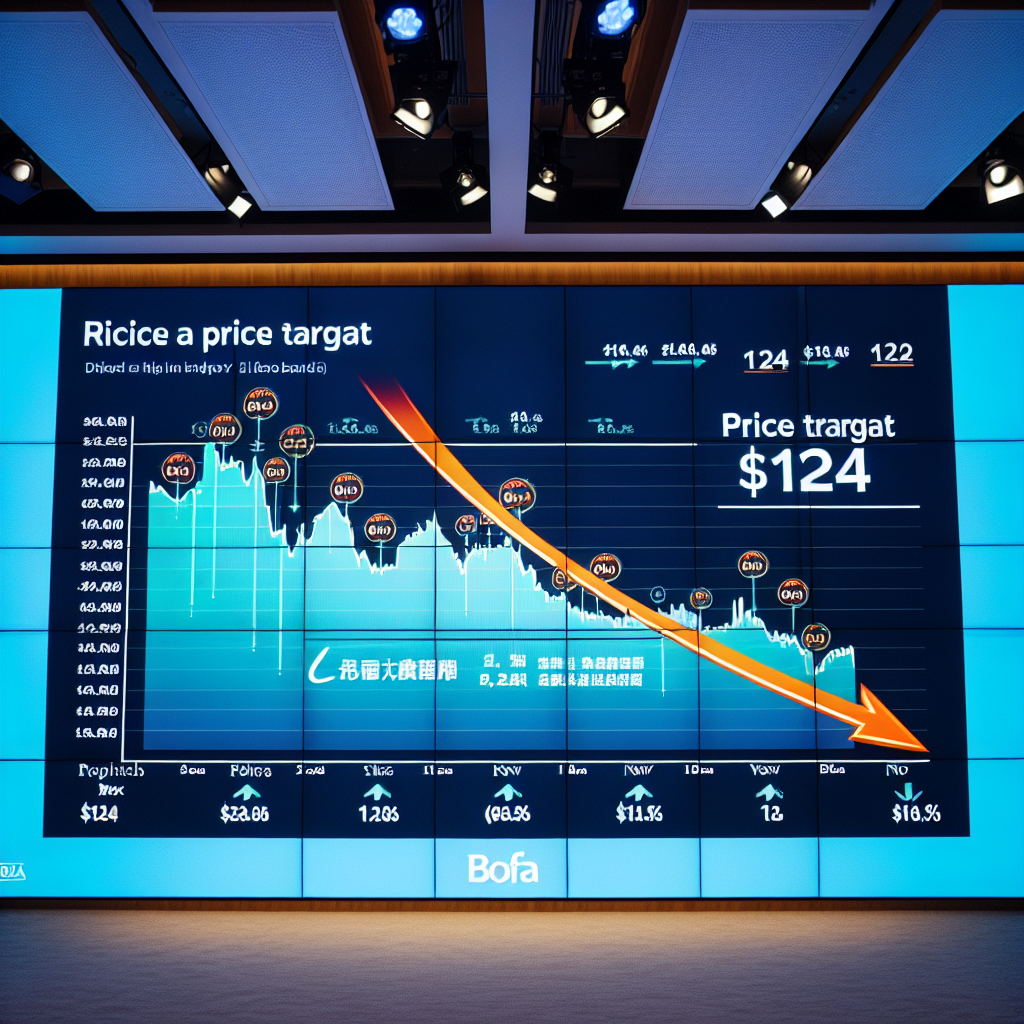“Bank of America Adjusts Alibaba’s Outlook: New Price Target Set at $112.”
Introduction
Bank of America (BofA) has revised its price target for Alibaba Group Holding Limited, lowering it from $124 to $112. This adjustment reflects a reassessment of Alibaba’s market position and potential growth prospects amid evolving economic conditions and regulatory challenges. The decision underscores the cautious sentiment among investors and analysts regarding the Chinese e-commerce giant’s future performance. BofA’s updated price target suggests a more conservative outlook on Alibaba’s ability to navigate the current business landscape and maintain its competitive edge.
Impact Of BofA’s Price Target Reduction On Alibaba’s Stock Performance
Bank of America (BofA) recently adjusted its price target for Alibaba Group Holding Limited, reducing it from $124 to $112. This decision has sparked discussions among investors and analysts regarding the potential implications for Alibaba’s stock performance. The revision of the price target reflects a reassessment of Alibaba’s current market conditions, competitive landscape, and future growth prospects. As investors digest this new information, it is crucial to understand the factors that may have influenced BofA’s decision and how it could impact Alibaba’s stock performance in the near term.
To begin with, the reduction in the price target may be attributed to several macroeconomic and company-specific factors. Globally, the economic environment remains uncertain, with concerns about inflation, interest rate hikes, and geopolitical tensions affecting investor sentiment. These factors can lead to increased volatility in the stock market, prompting analysts to adopt a more cautious outlook on growth-oriented companies like Alibaba. Furthermore, the ongoing regulatory scrutiny in China, particularly in the technology sector, has added another layer of complexity to Alibaba’s operating environment. The Chinese government’s tightening regulations on data privacy, antitrust issues, and financial technology have created headwinds for Alibaba, potentially impacting its revenue growth and profitability.
In addition to these external factors, Alibaba faces intensified competition within the e-commerce and cloud computing sectors. Domestic rivals such as JD.com and Pinduoduo continue to challenge Alibaba’s market share, while international players like Amazon pose a threat to its global expansion efforts. This competitive pressure necessitates increased investment in technology and innovation, which could strain Alibaba’s financial resources and affect its bottom line. Consequently, BofA’s revised price target may reflect concerns about Alibaba’s ability to maintain its competitive edge and achieve sustainable growth in the face of these challenges.
Despite these concerns, it is important to note that Alibaba remains a dominant player in the e-commerce and cloud computing markets, with a robust ecosystem that includes digital media, entertainment, and logistics services. The company’s strong brand recognition, extensive customer base, and technological capabilities provide a solid foundation for future growth. Moreover, Alibaba’s strategic initiatives, such as expanding its presence in international markets and investing in new business segments like digital payments and artificial intelligence, could unlock new revenue streams and drive long-term value creation.
As investors consider the implications of BofA’s price target reduction, it is essential to adopt a balanced perspective. While the revised target may signal caution, it does not necessarily imply a negative outlook for Alibaba’s stock performance. Instead, it highlights the need for investors to closely monitor the evolving market dynamics and assess Alibaba’s strategic responses to these challenges. In the short term, Alibaba’s stock may experience fluctuations as market participants react to the revised price target and other external factors. However, in the long run, Alibaba’s ability to adapt to changing market conditions and capitalize on growth opportunities will be crucial in determining its stock performance.
In conclusion, BofA’s decision to lower Alibaba’s price target to $112 from $124 underscores the complexities and uncertainties facing the company in the current market environment. While this adjustment may influence investor sentiment and short-term stock performance, Alibaba’s strong market position and strategic initiatives provide a foundation for potential growth. Investors should remain vigilant, considering both the risks and opportunities as they evaluate Alibaba’s future prospects.
Analyzing The Reasons Behind BofA’s Revised Price Target For Alibaba
Bank of America (BofA) recently revised its price target for Alibaba Group Holding Limited, reducing it from $124 to $112. This adjustment has sparked discussions among investors and analysts, prompting a closer examination of the factors influencing this decision. Understanding the rationale behind BofA’s revised price target requires an exploration of both macroeconomic conditions and company-specific developments that have impacted Alibaba’s performance and outlook.
To begin with, the global economic landscape has been fraught with challenges, including ongoing geopolitical tensions, fluctuating consumer demand, and supply chain disruptions. These factors have collectively contributed to a more cautious outlook for many multinational corporations, including Alibaba. The Chinese economy, in particular, has faced headwinds such as regulatory crackdowns on technology companies and a slowing growth rate. These macroeconomic pressures have inevitably affected Alibaba’s business operations and growth prospects, leading analysts to reassess their expectations.
Moreover, Alibaba has been navigating a complex regulatory environment in China, which has introduced additional uncertainties. The Chinese government’s increased scrutiny of technology giants has resulted in a series of regulatory measures aimed at curbing monopolistic practices and ensuring data security. These regulations have not only impacted Alibaba’s core e-commerce business but have also raised concerns about the company’s ability to expand its market share and maintain its competitive edge. Consequently, BofA’s decision to lower the price target reflects a more conservative stance in light of these regulatory challenges.
In addition to regulatory issues, Alibaba’s financial performance has also played a role in the revised price target. The company’s recent earnings reports have shown mixed results, with some segments experiencing slower growth than anticipated. For instance, while Alibaba’s cloud computing division has continued to grow, its e-commerce segment has faced increased competition from domestic rivals and a shift in consumer spending patterns. These dynamics have led to a reassessment of Alibaba’s revenue growth potential, prompting BofA to adjust its valuation model accordingly.
Furthermore, investor sentiment towards Chinese technology stocks has been volatile, influenced by both domestic and international factors. The ongoing trade tensions between the United States and China have added another layer of complexity, as investors weigh the potential impact on cross-border business operations and market access. This uncertainty has contributed to fluctuations in Alibaba’s stock price, making it challenging for analysts to maintain a stable outlook. BofA’s revised price target reflects an attempt to account for these market dynamics and provide a more realistic assessment of Alibaba’s future performance.
Despite these challenges, it is important to note that Alibaba remains a formidable player in the global e-commerce and technology sectors. The company’s investments in innovation, digital infrastructure, and international expansion continue to position it for long-term growth. However, the current environment necessitates a more cautious approach, as reflected in BofA’s revised price target. By considering both external and internal factors, BofA aims to provide investors with a balanced perspective on Alibaba’s potential risks and opportunities.
In conclusion, BofA’s decision to lower Alibaba’s price target from $124 to $112 is a reflection of the complex interplay between macroeconomic conditions, regulatory challenges, and company-specific performance. As Alibaba navigates these uncertainties, investors and analysts will continue to closely monitor developments to assess the company’s ability to adapt and thrive in an evolving landscape.
Investor Reactions To BofA’s New Price Target For Alibaba
Bank of America (BofA) recently adjusted its price target for Alibaba Group Holding Limited, reducing it from $124 to $112. This decision has sparked a range of reactions among investors, who are now reassessing their positions and strategies concerning the Chinese e-commerce giant. The revision comes amid a backdrop of fluctuating market conditions and evolving regulatory landscapes, both of which have significantly impacted Alibaba’s performance and outlook.
To begin with, BofA’s decision to lower the price target reflects a cautious stance on Alibaba’s near-term prospects. Analysts at the bank have cited several factors contributing to this adjustment, including ongoing regulatory scrutiny in China, which continues to pose challenges for major technology firms. The Chinese government’s increased focus on antitrust measures and data privacy has created an environment of uncertainty, leading investors to adopt a more conservative approach. Consequently, BofA’s revised target is seen as a reflection of these broader market dynamics.
Moreover, the global economic climate has also played a role in shaping investor sentiment. With concerns about inflation, supply chain disruptions, and geopolitical tensions, investors are increasingly wary of potential risks that could affect Alibaba’s growth trajectory. These macroeconomic factors have led to a more cautious outlook, prompting financial institutions like BofA to reassess their valuations of companies operating in volatile markets. As a result, the reduced price target is indicative of a more tempered expectation for Alibaba’s future performance.
In addition to external factors, Alibaba’s internal challenges have also influenced BofA’s decision. The company has faced intense competition from domestic rivals such as JD.com and Pinduoduo, which have been aggressively expanding their market share. This competitive pressure has necessitated increased investment in technology and infrastructure, potentially impacting Alibaba’s profitability in the short term. Furthermore, the company’s efforts to diversify its business model, while promising in the long run, may require significant capital expenditure, thereby affecting its financial outlook.
Despite these challenges, some investors remain optimistic about Alibaba’s long-term potential. They argue that the company’s strong fundamentals, including its vast user base and robust ecosystem, provide a solid foundation for future growth. Additionally, Alibaba’s strategic initiatives in cloud computing, digital media, and international expansion are seen as key drivers that could enhance its competitive edge over time. These investors view BofA’s revised price target as a temporary setback rather than a reflection of Alibaba’s intrinsic value.
Nevertheless, the reduction in the price target has prompted a reevaluation of investment strategies among market participants. Some investors may choose to adopt a wait-and-see approach, closely monitoring Alibaba’s performance in the coming quarters before making any significant moves. Others might consider diversifying their portfolios to mitigate potential risks associated with holding Alibaba shares. In this context, BofA’s revised target serves as a catalyst for broader discussions about risk management and investment diversification.
In conclusion, BofA’s decision to lower Alibaba’s price target to $112 from $124 has elicited varied reactions from investors, who are now navigating a complex landscape of regulatory challenges, economic uncertainties, and competitive pressures. While some remain confident in Alibaba’s long-term prospects, others are adopting a more cautious stance, reflecting the nuanced and multifaceted nature of investment decision-making in today’s dynamic market environment. As the situation continues to evolve, investors will undoubtedly keep a close eye on Alibaba’s strategic initiatives and market developments to inform their future actions.
Comparing BofA’s Alibaba Price Target With Other Financial Institutions

Bank of America (BofA) recently adjusted its price target for Alibaba Group Holding Limited, reducing it from $124 to $112. This revision reflects a cautious stance amid evolving market conditions and the company’s performance metrics. To better understand the implications of this adjustment, it is essential to compare BofA’s revised target with those set by other prominent financial institutions. Such a comparison provides a broader perspective on Alibaba’s market valuation and the varying expectations of financial analysts.
Firstly, it is important to note that BofA’s decision to lower its price target is not an isolated event. Several factors, including regulatory challenges, macroeconomic conditions, and competitive pressures, have influenced analysts’ outlooks on Alibaba. These elements have contributed to a more conservative approach by financial institutions when assessing the company’s future performance. In this context, BofA’s revised target aligns with a trend of cautious optimism, balancing potential growth opportunities with inherent risks.
In contrast, other financial institutions have set different price targets for Alibaba, reflecting diverse assessments of the company’s prospects. For instance, Morgan Stanley has maintained a more optimistic view, setting a price target of $130. This target suggests confidence in Alibaba’s ability to navigate regulatory hurdles and capitalize on its expansive e-commerce and cloud computing operations. Morgan Stanley’s analysis likely considers Alibaba’s strategic initiatives, such as its investments in technology and international expansion, which could drive long-term growth.
On the other hand, institutions like Goldman Sachs have adopted a more conservative stance, with a price target of $115. This target indicates a tempered outlook, acknowledging both the potential for growth and the challenges posed by China’s regulatory environment. Goldman Sachs’ assessment may also factor in the competitive landscape, where Alibaba faces increasing competition from domestic rivals like JD.com and Pinduoduo, as well as global players such as Amazon.
Furthermore, JPMorgan Chase has set a price target of $118, positioning itself between the more optimistic and conservative estimates. This target reflects a balanced view, recognizing Alibaba’s strengths in innovation and market leadership while remaining mindful of external pressures. JPMorgan’s analysis likely considers the company’s financial health, including its revenue growth and profitability, as well as its ability to adapt to changing consumer behaviors and technological advancements.
In summary, the variation in price targets among financial institutions underscores the complexity of evaluating Alibaba’s market position. While BofA’s reduction to $112 highlights a cautious approach, other institutions like Morgan Stanley and Goldman Sachs offer differing perspectives based on their analyses of the company’s strategic direction and external factors. These differences illustrate the multifaceted nature of financial forecasting, where analysts must weigh numerous variables to arrive at their conclusions.
Ultimately, investors should consider these diverse viewpoints when making decisions about Alibaba’s stock. By examining the range of price targets and the rationale behind them, investors can gain a more comprehensive understanding of the potential risks and rewards associated with Alibaba. This holistic approach enables informed decision-making, taking into account both the opportunities for growth and the challenges that lie ahead in an ever-evolving market landscape.
Long-term Implications Of BofA’s Price Target Adjustment On Alibaba
Bank of America’s recent decision to reduce Alibaba’s price target from $124 to $112 has sparked considerable discussion among investors and market analysts. This adjustment reflects a reassessment of Alibaba’s future prospects, influenced by a variety of factors that could have long-term implications for the company. Understanding these implications requires a closer examination of the underlying reasons for the adjustment and the broader context in which Alibaba operates.
To begin with, the reduction in the price target is indicative of a more cautious outlook on Alibaba’s growth trajectory. This caution is not unfounded, as the company has been navigating a complex landscape marked by regulatory challenges, both domestically and internationally. In China, Alibaba has faced increased scrutiny from regulators, which has led to significant fines and operational adjustments. These regulatory pressures have inevitably affected investor confidence, prompting financial institutions like Bank of America to reassess their projections.
Moreover, the global economic environment has also played a role in shaping expectations for Alibaba. The ongoing trade tensions between the United States and China have created an atmosphere of uncertainty, impacting Chinese tech giants’ ability to expand and operate freely in international markets. This geopolitical backdrop has made investors wary, as any escalation in tensions could further hinder Alibaba’s growth prospects. Consequently, Bank of America’s revised price target reflects these geopolitical risks, acknowledging the potential for adverse developments that could affect Alibaba’s performance.
In addition to regulatory and geopolitical factors, Alibaba’s competitive landscape has also evolved. The rise of domestic competitors, such as JD.com and Pinduoduo, has intensified the battle for market share within China. These companies have been aggressive in their strategies, leveraging technology and innovation to capture consumer attention. As a result, Alibaba faces the challenge of maintaining its dominant position while also seeking new avenues for growth. This competitive pressure is another reason why Bank of America might have opted for a more conservative price target.
Furthermore, the global shift towards digitalization and e-commerce presents both opportunities and challenges for Alibaba. While the company has been a pioneer in the e-commerce space, the rapid pace of technological advancement means that it must continuously innovate to stay ahead. This necessity for constant innovation requires substantial investment, which could impact profitability in the short term. Bank of America’s adjustment may also take into account the potential financial strain associated with these investments, as Alibaba seeks to maintain its leadership in a rapidly changing industry.
Despite these challenges, it is important to recognize that Alibaba remains a formidable player in the global market. The company’s diverse portfolio, which includes cloud computing, digital media, and logistics, provides a strong foundation for future growth. However, the reduced price target serves as a reminder that even industry leaders are not immune to external pressures and must adapt to an ever-evolving landscape.
In conclusion, Bank of America’s decision to lower Alibaba’s price target to $112 underscores the complex interplay of regulatory, geopolitical, and competitive factors that the company must navigate. While the adjustment reflects a more cautious outlook, it also highlights the need for Alibaba to strategically address these challenges to sustain its long-term growth. Investors and stakeholders will undoubtedly be watching closely as Alibaba continues to adapt and evolve in response to these dynamic conditions.
How BofA’s Price Target Reduction Reflects On Alibaba’s Market Position
Bank of America’s recent decision to reduce Alibaba’s price target from $124 to $112 has sparked considerable discussion among investors and market analysts. This adjustment reflects a broader reassessment of Alibaba’s market position amidst a rapidly evolving economic landscape. To understand the implications of this change, it is essential to consider the factors influencing Bank of America’s decision and how they relate to Alibaba’s current standing in the global market.
Firstly, the reduction in the price target can be attributed to a combination of macroeconomic and company-specific factors. On a macroeconomic level, the global economy is experiencing significant volatility, driven by geopolitical tensions, fluctuating consumer demand, and ongoing supply chain disruptions. These factors have collectively contributed to a more cautious outlook for many multinational corporations, including Alibaba. As a major player in the e-commerce and technology sectors, Alibaba is particularly sensitive to shifts in consumer spending and international trade dynamics.
Moreover, regulatory pressures in China have also played a crucial role in shaping the market’s perception of Alibaba. Over the past few years, the Chinese government has intensified its scrutiny of major technology companies, implementing stricter regulations to ensure fair competition and data security. This regulatory environment has created an atmosphere of uncertainty, prompting investors to reassess the growth prospects of companies like Alibaba. Consequently, Bank of America’s revised price target reflects these heightened regulatory risks, which could potentially impact Alibaba’s ability to expand its market share and maintain its competitive edge.
In addition to these external factors, Alibaba’s internal performance metrics have also influenced the revised price target. While the company has demonstrated resilience in navigating challenging market conditions, certain aspects of its business have faced headwinds. For instance, Alibaba’s core e-commerce segment has encountered increased competition from both domestic and international rivals, necessitating strategic investments in technology and logistics to sustain growth. Furthermore, the company’s cloud computing division, although growing, has yet to achieve the profitability levels anticipated by some investors. These internal challenges underscore the need for Alibaba to adapt its business strategies to maintain its leadership position in the industry.
Despite these challenges, it is important to recognize that Alibaba remains a formidable force in the global market. The company’s diverse portfolio, which includes e-commerce, cloud computing, digital media, and financial services, provides a solid foundation for future growth. Additionally, Alibaba’s commitment to innovation and its ability to leverage data-driven insights offer significant opportunities for expansion in emerging markets and new business verticals. Therefore, while the reduced price target may signal caution, it does not necessarily diminish Alibaba’s long-term potential.
In conclusion, Bank of America’s decision to lower Alibaba’s price target to $112 reflects a nuanced assessment of the company’s market position amidst a complex and dynamic environment. By considering both external and internal factors, this adjustment highlights the challenges and opportunities that lie ahead for Alibaba. As the company continues to navigate regulatory pressures, competitive dynamics, and evolving consumer preferences, its ability to adapt and innovate will be crucial in shaping its future trajectory. Investors and market observers will undoubtedly keep a close watch on Alibaba’s strategic initiatives and performance metrics as they seek to understand the implications of this revised price target on the company’s overall market position.
Strategies For Alibaba Investors In Light Of BofA’s Price Target Change
In the ever-evolving landscape of global finance, investors are constantly seeking insights and strategies to navigate the complexities of the market. Recently, Bank of America (BofA) made headlines by adjusting its price target for Alibaba Group Holding Limited, reducing it from $124 to $112. This revision has prompted investors to reassess their strategies concerning Alibaba, a leading player in the e-commerce and technology sectors. Understanding the implications of this change is crucial for investors aiming to make informed decisions.
To begin with, it is essential to comprehend the rationale behind BofA’s decision to lower Alibaba’s price target. Analysts often adjust price targets based on a myriad of factors, including changes in market conditions, company performance, and broader economic indicators. In Alibaba’s case, the reduction may reflect concerns over regulatory challenges, competitive pressures, or shifts in consumer behavior. By acknowledging these factors, investors can better evaluate the potential risks and opportunities associated with Alibaba’s stock.
In light of BofA’s revised price target, investors should consider adopting a diversified approach to their portfolios. Diversification is a fundamental strategy that helps mitigate risk by spreading investments across various asset classes and sectors. By not overly concentrating on a single stock, such as Alibaba, investors can protect themselves from potential volatility and unforeseen market fluctuations. This approach allows for a more balanced portfolio that can withstand changes in individual stock performance.
Moreover, investors should remain vigilant and stay informed about Alibaba’s ongoing developments. The company operates in a dynamic industry characterized by rapid technological advancements and shifting consumer preferences. Keeping abreast of Alibaba’s strategic initiatives, such as its expansion into cloud computing and international markets, can provide valuable insights into its long-term growth prospects. By staying informed, investors can make timely decisions that align with their investment goals.
Additionally, it is prudent for investors to consider the broader macroeconomic environment when evaluating Alibaba’s stock. Factors such as global trade tensions, currency fluctuations, and economic growth rates can significantly impact the company’s performance. For instance, changes in China’s economic policies or international trade agreements may influence Alibaba’s operations and profitability. By understanding these external factors, investors can better anticipate potential challenges and adjust their strategies accordingly.
Furthermore, investors should not overlook the importance of conducting thorough fundamental analysis. This involves examining Alibaba’s financial statements, revenue growth, profit margins, and other key performance indicators. By analyzing these metrics, investors can gain a deeper understanding of the company’s financial health and its ability to generate sustainable returns. This analytical approach enables investors to make informed decisions based on objective data rather than relying solely on market sentiment or analyst recommendations.
In conclusion, BofA’s decision to lower Alibaba’s price target to $112 serves as a reminder of the dynamic nature of the financial markets. For investors, this adjustment underscores the importance of adopting a diversified approach, staying informed about company developments, considering macroeconomic factors, and conducting thorough fundamental analysis. By employing these strategies, investors can navigate the complexities of the market with greater confidence and make informed decisions that align with their long-term investment objectives. As the financial landscape continues to evolve, maintaining a proactive and informed approach will be key to achieving success in the ever-changing world of investing.
Q&A
1. **What is the new price target for Alibaba set by BofA?**
$112
2. **What was the previous price target for Alibaba set by BofA?**
$124
3. **Which financial institution reduced Alibaba’s price target?**
Bank of America (BofA)
4. **By how much did BofA reduce Alibaba’s price target?**
By $12
5. **What is the ticker symbol for Alibaba?**
BABA
6. **What is the primary reason for BofA’s reduction in Alibaba’s price target?**
Specific reasons are not provided in the question, but such adjustments are typically due to changes in market conditions, company performance, or economic outlook.
7. **What impact might this price target reduction have on Alibaba’s stock?**
It could potentially lead to a decrease in investor confidence and a decline in the stock price, although actual market reactions can vary.
Conclusion
Bank of America (BofA) has lowered its price target for Alibaba from $124 to $112. This adjustment likely reflects concerns over Alibaba’s recent financial performance, market conditions, or broader economic factors affecting the company’s growth prospects. The reduced target suggests a more cautious outlook on Alibaba’s future stock performance, possibly due to regulatory challenges, competitive pressures, or macroeconomic uncertainties impacting the Chinese tech sector. Investors may interpret this as a signal to reassess their expectations and strategies regarding Alibaba’s stock.





